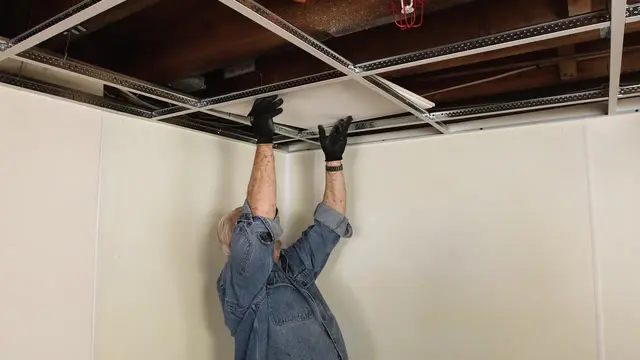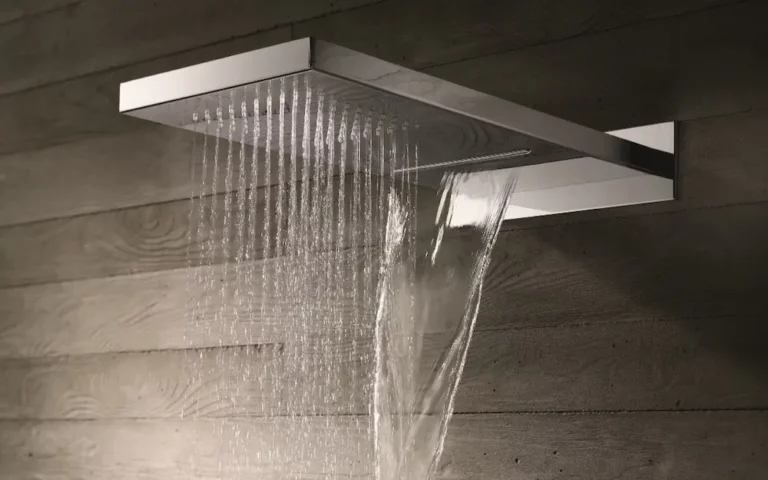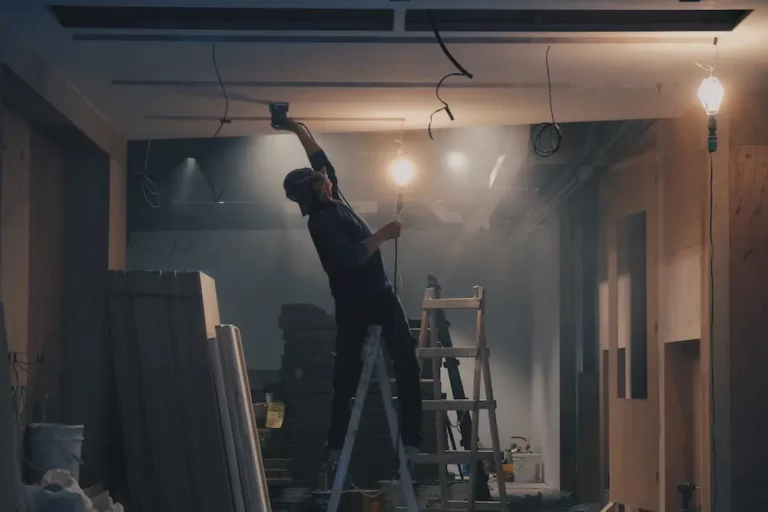Drop Ceiling vs Drywall in Basement: Which is Better?
When it comes to finishing a basement, one of the biggest decisions you’ll have to make is whether to install a drop ceiling or drywall ceiling. Both options have their pros and cons, so it’s important to carefully consider your needs and preferences before making a decision.
A drop ceiling, also known as a suspended ceiling, is a system of tiles or panels that are suspended from the ceiling joists by metal grids. This type of ceiling is popular in basements because it allows easy access to the plumbing, electrical, and HVAC systems that often run through the ceiling. It also provides a clean and finished look to the space. On the other hand, drywall ceilings are made of gypsum panels that are screwed directly to the ceiling joists. This type of ceiling is more traditional and can give a room a more polished look. However, it can be more difficult to access the systems above the ceiling if needed.
Understanding Drop Ceilings
When it comes to finishing a basement, one of the decisions you’ll need to make is whether to go with a drop ceiling or drywall. In this section, I’ll focus on drop ceilings and what you need to know before making a decision.
Benefits of Drop Ceilings
One of the main benefits of drop ceilings is that they’re easy to install. Unlike drywall, which requires a lot of measuring, cutting, and hanging, drop ceilings are made up of tiles that fit into a grid system. This makes it a great DIY project for those who want to save money on installation costs.
Another benefit of drop ceilings is that they provide easy access to the space above. If you have mechanicals like plumbing or electrical wiring running through your basement ceiling, a drop ceiling can make it easy to access them if you need to make repairs or upgrades in the future.
Drop ceilings also offer a lot of design options. You can choose from a variety of tile styles, colors, and textures to create a unique look for your basement. Some drop ceiling tiles even have acoustic properties, which can help reduce noise in the basement.
Drawbacks of Drop Ceilings
While drop ceilings have their benefits, they also have a few drawbacks to consider. One of the biggest drawbacks is that they can make a room feel shorter. Since the tiles sit below the ceiling joists, they can lower the height of the ceiling by a few inches. This can make a basement feel cramped or claustrophobic.
Another drawback of drop ceilings is that they can be more expensive than drywall. While the installation costs may be lower, the cost of the materials can add up quickly. Additionally, drop ceilings may need to be replaced over time if the tiles become damaged or stained.
Finally, drop ceilings may not be the best choice if you’re looking for a sleek, modern look. While there are a lot of design options available, drop ceilings can still look dated or old-fashioned compared to a smooth, seamless drywall ceiling.
Overall, drop ceilings can be a great choice for those who want an easy-to-install, versatile ceiling option with easy access to mechanicals. However, they may not be the best choice if you’re looking for a modern, seamless look or if you’re working with a tight budget.
Understanding Drywall in Basement
When it comes to finishing a basement, drywall is a popular choice for creating a clean and polished look. As someone who has finished a basement with drywall, I can attest to both the benefits and drawbacks of this option.
Benefits of Drywall
One of the biggest benefits of using drywall in a basement is that it creates a smooth and seamless surface. This can give the space a more polished and finished look, making it feel like an extension of the home rather than a dark and dingy basement.
Another benefit of drywall is that it can help with soundproofing. If you plan on using your basement as a home theater or music room, drywall can help to absorb sound and prevent it from traveling to other parts of the house.
Drywall is also a relatively inexpensive option compared to other finishing materials, making it a great choice for those on a budget.
Drawbacks of Drywall
While drywall has its benefits, there are also some drawbacks to consider. One of the biggest drawbacks is that it can be difficult to install, especially for those who are not experienced with this type of work. It requires a lot of measuring, cutting, and hanging, which can be time-consuming and frustrating.
Another drawback of drywall is that it is not as durable as other finishing materials. It can be easily damaged by moisture, which is a common problem in basements. If your basement is prone to flooding or high levels of humidity, drywall may not be the best option.
Finally, drywall can be difficult to repair if it does become damaged. It may require removing and replacing entire sections, which can be costly and time-consuming.
Overall, drywall can be a great choice for finishing a basement if you are looking for a polished and seamless look. However, it is important to consider the drawbacks and make sure it is the right choice for your specific needs and budget.
Cost Comparison: Drop Ceiling vs Drywall
When it comes to cost, there is a significant difference between drop ceilings and drywall. Let’s take a closer look at how they compare.
Drop Ceiling
Drop ceilings are generally cheaper than drywall ceilings. The materials required for installing a drop ceiling are less expensive, and the installation process is quicker and easier. Drop ceilings come in a variety of materials, including PVC, vinyl, and metal, with prices ranging from $1 to $4 per square foot.
The cost of installation for a drop ceiling is also lower than that of drywall. A DIY installation can save you even more money. However, if you hire a professional, the cost can range from $2 to $5 per square foot, depending on the complexity of the project.
Drywall
Drywall is more expensive than drop ceilings, both in terms of materials and installation costs. The materials required for drywall installation are more expensive than those for drop ceilings. Drywall sheets cost between $0.40 and $0.65 per square foot, but the cost of finishing materials such as tape, mud, and sandpaper can add up quickly.
The installation of drywall is also more complex and time-consuming than that of drop ceilings. It requires more skill and experience, and mistakes can be costly to fix. A professional installation can cost between $1.50 and $3 per square foot, and the cost can be higher if the ceiling is high or has complex angles.
In conclusion, drop ceilings are generally cheaper than drywall ceilings. The cost of materials and installation is lower, and they are easier to install. However, drywall ceilings are more durable and require less maintenance, which may make them a better long-term investment. Ultimately, the choice between drop ceilings and drywall will depend on your budget, preferences, and the specific needs of your basement.
Installation Process: Drop Ceiling vs Drywall
When it comes to the installation process, there are some key differences between a drop ceiling and drywall in a basement. Here are a few things to consider:
Drop Ceiling Installation Process
Installing a drop ceiling is generally considered to be a bit easier than installing drywall. The process involves attaching a grid of metal tracks to the ceiling using screws or adhesive, and then inserting ceiling tiles into the grid. This can be done by one person, although it is easier with two people.
One of the advantages of a drop ceiling is that it is easy to work around obstacles like pipes and ducts. The tiles can be easily removed and replaced, making it simple to access the area above the ceiling if needed.
Drywall Installation Process
Installing drywall is a bit more involved than installing a drop ceiling. It typically requires two people to handle the large sheets of drywall, and the installation process involves cutting the sheets to size, attaching them to the ceiling joists with screws, and then taping and finishing the seams.
One advantage of drywall is that it can provide a smoother, more seamless finish than a drop ceiling. However, it can be more difficult to work around obstacles like pipes and ducts, and accessing the area above the ceiling can be more challenging.
Overall, both drop ceilings and drywall have their pros and cons when it comes to the installation process. It’s important to consider factors like ease of installation, access to the area above the ceiling, and the desired finished look when deciding which option is best for your basement.
Maintenance: Drop Ceiling vs Drywall
When it comes to maintenance, drop ceilings have a clear advantage over drywall. Drop ceilings are easier to maintain and repair, as individual tiles can be easily replaced if they become damaged or stained. On the other hand, if a section of drywall becomes damaged, it typically needs to be cut out and replaced entirely, which can be a more time-consuming and costly process.
In addition to being easier to repair, drop ceilings are also less likely to need repairs in the first place. This is because drop ceilings are designed to be more durable and resistant to damage than drywall. Drop ceiling tiles are typically made of materials like fiberglass or mineral wool, which are less prone to cracking, warping, or sagging than drywall.
Another advantage of drop ceilings when it comes to maintenance is that they are easier to clean than drywall. Drop ceiling tiles can be wiped down or vacuumed to remove dust and dirt, while drywall requires more intensive cleaning methods like scrubbing or sanding.
Overall, when it comes to maintenance, drop ceilings are the clear winner. They are easier to repair, less likely to need repairs in the first place, and easier to clean than drywall.
Noise Insulation: Drop Ceiling vs Drywall
When it comes to basement renovations, noise insulation is a crucial factor to consider. Both drop ceiling and drywall have their unique features that can help in noise insulation. In this section, I will discuss the noise insulation properties of drop ceiling and drywall.
Drop Ceiling
Drop ceiling tiles can be an excellent option for noise insulation. These tiles are made of materials like mineral fiber, fiberglass, and PVC. They have sound-absorbing properties and can reduce noise transmission from the basement to the upper floors. The tiles have a porous surface that can absorb sound waves, preventing them from bouncing back into the room.
Moreover, drop ceilings can be installed with an air gap between the tiles and the floor above. This air gap can act as a barrier to noise transmission, reducing the amount of noise that passes through the ceiling. The installation of a drop ceiling can also help in soundproofing the basement by blocking sound from entering the room.
Drywall
Drywall is another option for noise insulation in the basement. It is a dense material that can block sound waves from passing through. Drywall can be installed with additional layers to increase its noise insulation properties. For example, a double layer of drywall with a layer of soundproofing material in between can significantly reduce noise transmission.
However, drywall alone may not be enough to provide adequate noise insulation. It can only block sound waves from passing through it, but it cannot absorb them. Therefore, it may be necessary to install additional sound-absorbing materials like acoustic panels or curtains to improve noise insulation.
Conclusion
Both drop ceiling and drywall have their unique features that can help in noise insulation. Drop ceilings can absorb sound waves and create an air gap to reduce noise transmission, while drywall can block sound waves from passing through. However, the best option for noise insulation depends on various factors like budget, personal preference, and the extent of noise transmission.
Final Verdict: Drop Ceiling or Drywall in Basement
After weighing the pros and cons of both drop ceiling and drywall options for your basement, it’s time to make a final decision. Ultimately, the choice will depend on your personal preferences and needs. Here are some factors to consider before making your decision:
Accessibility
If you need easy access to your basement’s mechanicals, such as plumbing or electrical systems, then a drop ceiling is the way to go. With drop ceilings, you can easily remove tiles to access these systems. On the other hand, if you don’t need frequent access to your basement’s mechanicals, then drywall may be a better option.
Aesthetics
If you want a more finished and seamless look, then drywall is the way to go. Drywall can give your basement a more polished and modern look. However, if you prefer a more industrial or retro look, then drop ceilings may be the better option.
Installation
If you are a DIY enthusiast, then a drop ceiling may be the easier option for you. Drop ceilings are easier to install and can be done by one person. Drywall installation, on the other hand, requires more expertise and usually requires hiring a professional.
Cost
Drop ceilings are generally more affordable than drywall, making them the more budget-friendly option. However, if you are looking for a more high-end finish, then drywall may be worth the extra cost.
In the end, the decision between drop ceiling and drywall will depend on your specific needs and preferences. Consider the factors above before making your final decision, and remember that both options have their benefits and drawbacks.





